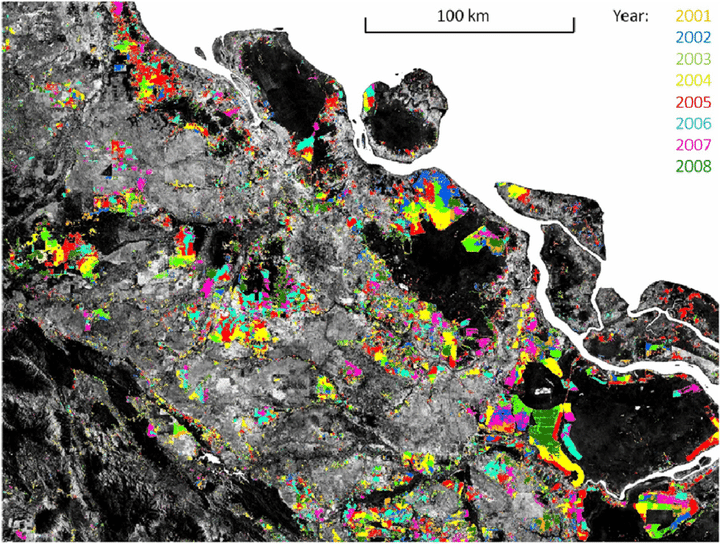Remotely sensed forest cover loss shows high spatial and temporal variation across Sumatera and Kalimantan, Indonesia 2000–2008
 From the article, “Temporal disaggregation of the moderate spatial resolution forest cover loss map for Riau province, Sumatera. Landsat band 5 is displayed in grayscale with dark tones representing forest cover. Colors mark the year of MODIS-detected forest cover loss.”
From the article, “Temporal disaggregation of the moderate spatial resolution forest cover loss map for Riau province, Sumatera. Landsat band 5 is displayed in grayscale with dark tones representing forest cover. Colors mark the year of MODIS-detected forest cover loss.”Abstract
The Indonesian islands of Sumatera and Kalimantan (the Indonesian part of the island of Borneo) are a center of significant and rapid forest cover loss in the humid tropics with implications for carbon dynamics, biodiversity conservation, and local livelihoods. The aim of our research was to analyze and interpret annual trends of forest cover loss for different sub-regions of the study area. We mapped forest cover loss for 2000–2008 using multi-resolution remote sensing data from the Landsat enhanced thematic mapper plus (ETM +) and moderate resolution imaging spectroradiometer (MODIS) sensors and analyzed annual trends per island, province, and official land allocation zone. The total forest cover loss for Sumatera and Kalimantan 2000–2008 was 5.39 Mha, which represents 5.3% of the land area and 9.2% of the year 2000 forest cover of these two islands. At least 6.5% of all mapped forest cover loss occurred in land allocation zones prohibiting clearing. An additional 13.6% of forest cover loss occurred where clearing is legally restricted. The overall trend of forest cover loss increased until 2006 and decreased thereafter. The trends for Sumatera and Kalimantan were distinctly different, driven primarily by the trends of Riau and Central Kalimantan provinces, respectively. This analysis shows that annual mapping of forest cover change yields a clearer picture than a one-time overall national estimate. Monitoring forest dynamics is important for national policy makers, especially given the commitment of Indonesia to reducing greenhouse gas emissions as part of the reducing emissions from deforestation and forest degradation in developing countries initiative (REDD +). The improved spatio-temporal detail of forest change monitoring products will make it possible to target policies and projects in meeting this commitment. Accurate, annual forest cover loss maps will be integral to many REDD + objectives, including policy formulation, definition of baselines, detection of displacement, and the evaluation of the permanence of emission reduction.